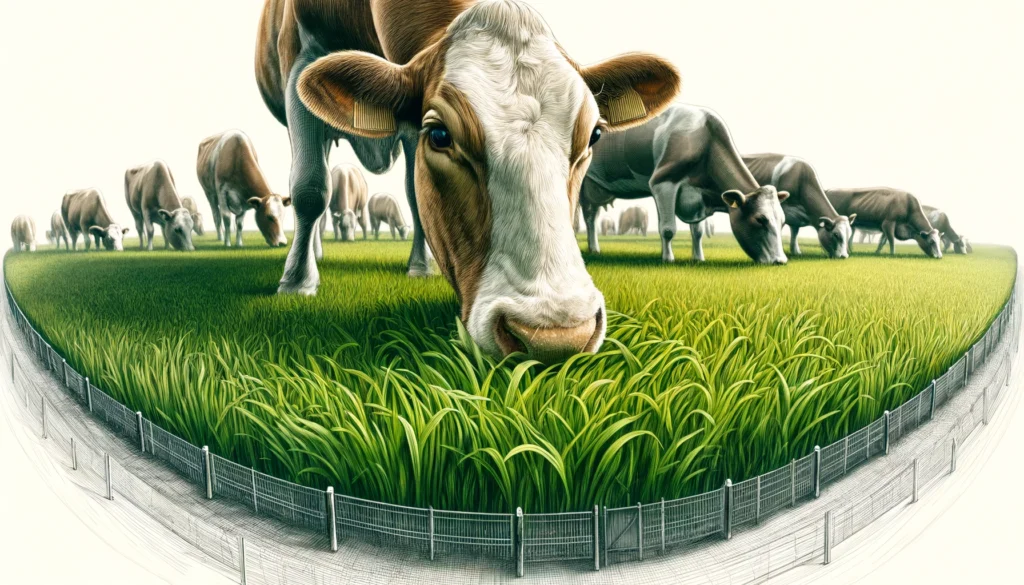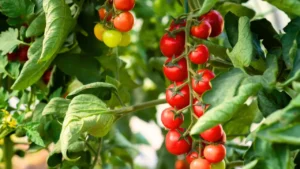
Grazing Management A detailed close up illustration of cattle grazing focusing intensely on a single cow within a rotational grazing system depicted in a wide aspect. 1.webp.webp
Grazing Management
Definition:
Grazing management refers to the strategic planning, implementation, and monitoring of grazing practices in pasture-based livestock production systems to optimize forage utilization, animal performance, environmental sustainability, and economic viability.
Insightful Analysis:
Grazing management is a dynamic and multifaceted aspect of livestock production that involves balancing the nutritional needs of grazing animals with the ecological requirements of pastures and rangelands, as well as the social and economic priorities of farmers and land managers.
Fall off the barn roof and busted your keister? Life on the farm or ranch can be tough on the bum. Need a break? Laugh it off at FarmerCowboy.com, the #1 farm humor site. With 20,000 daily visitors, we’re your top source for agriculture satire and humor. Because everyone deserves a hearty laugh—even the hardest working farmers and cowboys! Join us and turn those long days into fun tales at FarmerCowboy.com.
Guidance for Application:
1. Grazing System Design: Designing a grazing system involves considering factors such as pasture layout, stocking density, rotation frequency, rest periods, and forage species composition to maximize forage availability, quality, and regrowth while minimizing overgrazing, soil erosion, and pasture degradation.
2. Rotational Grazing Techniques: Implementing rotational grazing techniques, such as strip grazing, cell grazing, and intensive rotational grazing (IRG), allows for more efficient utilization of pasture resources by confining animals to smaller paddocks or grazing areas for short periods, followed by adequate rest and recovery periods to promote grass growth and soil health.
3. Forage Management Practices: Managing forage resources involves selecting appropriate forage species, improving pasture fertility and soil health through fertilization, liming, and soil amendments, and implementing practices such as overseeding, intercropping, and weed control to enhance forage quality, quantity, and persistence.
4. Water Provision and Distribution: Ensuring adequate water provision and distribution is essential for supporting livestock hydration, nutrient intake, and productivity during grazing periods. Installing water sources, such as troughs, ponds, or pipelines, in strategic locations throughout grazing areas helps to minimize animal travel distances and optimize grazing distribution.
5. Environmental Stewardship: Promoting environmental stewardship involves adopting sustainable grazing practices that enhance ecosystem health, biodiversity, and carbon sequestration in pastures and rangelands. This may include implementing riparian buffers, rotational grazing, prescribed burning, and native grass restoration to improve habitat quality and reduce environmental impacts.
6. Livestock Health and Welfare: Ensuring livestock health and welfare requires providing adequate nutrition, shelter, and healthcare services to grazing animals, as well as implementing disease prevention measures, parasite control strategies, and vaccination programs to minimize health risks and promote animal well-being.
7. Economic Viability and Risk Management: Optimizing economic viability and risk management in grazing systems involves balancing production costs, revenues, and profitability with potential risks and uncertainties, such as weather variability, market fluctuations, and input costs. This may include diversifying income streams, optimizing grazing strategies, and leveraging government programs and insurance options to mitigate financial risks and enhance farm resilience.
Practical Recommendations for Livestock Producers:
- Develop a comprehensive grazing management plan that integrates ecological, economic, and social considerations to optimize pasture utilization, animal performance, and environmental sustainability.
- Conduct regular pasture assessments, soil tests, and forage analyses to monitor pasture condition, nutrient status, and forage quality, and adjust grazing strategies accordingly to maintain optimal productivity and resilience.
- Implement rotational grazing systems and intensive grazing practices that mimic natural grazing patterns and promote forage regrowth, soil fertility, and biodiversity, while reducing the risk of overgrazing and pasture degradation.
- Invest in infrastructure improvements, such as fencing, water systems, and shade structures, to enhance grazing efficiency, animal welfare, and environmental stewardship in grazing areas.
- Collaborate with extension agents, conservation organizations, and other stakeholders to access technical assistance, financial support, and educational resources for implementing sustainable grazing practices and improving farm profitability and resilience.
In summary, grazing management is a critical component of sustainable livestock production that requires careful planning, monitoring, and adaptation to optimize forage utilization, animal performance, and environmental stewardship. By implementing effective grazing strategies and stewardship practices, livestock producers can enhance the resilience, productivity, and sustainability of their grazing systems while ensuring the health and welfare of their animals and the integrity of the surrounding ecosystem.
References:
- Teague, W. R., Provenza, F. D., Kreuter, U. P., Steffens, T., Barnes, M., & Conover, D. M. (2013). Multi-paddock grazing on rangelands: Why the perceptual dichotomy between research results and rancher experience? Journal of Environmental Management, 128, 699-717. Link
- Holechek, J. L., Pieper, R. D., & Herbel, C. H. (2018). Range Management: Principles and Practices (7th ed.). Pearson.
- Gerrish, J. (2009). Management-intensive Grazing: The Grassroots of Grass Farming. Green Park Press.






Originally posted 2022-09-03 04:34:35.
Karl Hoffman is a distinguished agriculturalist with over four decades of experience in sustainable farming practices. He holds a Ph.D. in Agronomy from Cornell University and has made significant contributions as a professor at Iowa State University. Hoffman’s groundbreaking research on integrated pest management and soil health has revolutionized modern agriculture. As a respected farm journalist, his column “Field Notes with Karl Hoffman” and his blog “The Modern Farmer” provide insightful, practical advice to a global audience. Hoffman’s work with the USDA and the United Nations FAO has enhanced food security worldwide. His awards include the USDA’s Distinguished Service Award and the World Food Prize, reflecting his profound impact on agriculture and sustainability.






